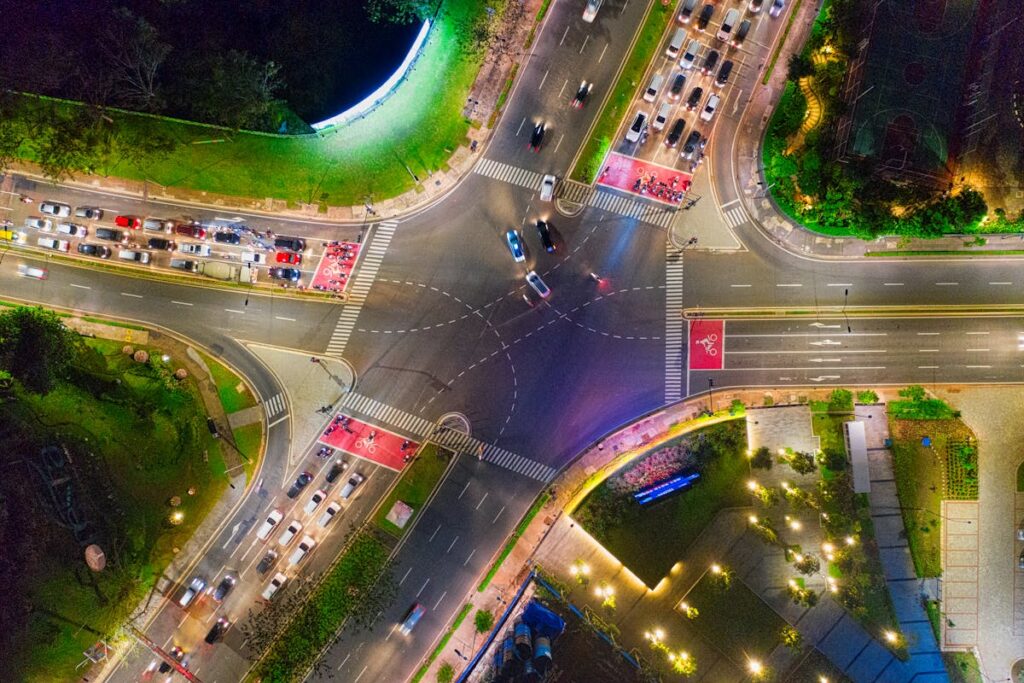The ceaseless evolution of road design, aimed at the prevention of accidents, has witnessed a monumental transformation from rudimentary paths to complex systems that guarantee safety. Over time, innovations such as traffic signals, road markings, and roundabouts have been introduced to manage vehicular flow and mitigate collision risks. In more recent years, the advent of Intelligent Transportation Systems and vehicle-to-infrastructure communication has enhanced real-time responsiveness, while the incorporation of smart materials and predictive analytics further fortifies safety measures. As we explore deeper into this topic, one is left to wonder, what does the future hold for accident-prevention road design?
Early Road Design and Safety Measures
Pioneering the rudimentary paths of human civilization, early road design played a quintessential role in shaping society as we perceive it. Before the advent of modern technology, road designs were primarily focused on facilitating travel rather than ensuring safety. The primitive road conditions consisted of dirt paths, stone-paved streets, or wooden planks, depending on the region and era. These scenarios often posed challenges regarding maintaining the safety of travelers.
Historical roadway safety was generally an afterthought, primarily because the slow travel speeds and low traffic density did not necessitate the need for complex safety measures. However, some early civilizations did incorporate rudimentary safety measures. For instance, in ancient Rome, stones known as ‘stepping stones’ were strategically placed to allow pedestrians to cross the road without having to step onto the road surface, thereby minimizing potential accidents.
Nevertheless, the primitive road conditions and the absence of extensive safety measures often led to accidents, underscoring the need for more thoughtful road design. The evolution of road design, consequently, has been a continuous process, informed by the historical challenges and the ongoing pursuit of improving safety for all road users.
Role of Traffic Signals in Accident Prevention
In the domain of road design, the introduction of traffic signals marked a monumental stride towards enhancing road safety and accident prevention. These devices, employing a system of lights, control the flow of traffic at major intersections, thereby reducing the risk of collisions that arise due to unregulated movement of vehicles.
A significant aspect of their functionality lies in traffic signal timing. This guarantees a structured flow of traffic, reducing the chances of accidents due to abrupt halts or reckless speeding. The timing of these signals is designed to be flexible, adapting to the varying traffic conditions at different times of the day.
Furthermore, traffic signals are instrumental in pedestrian safety. Crosswalk signals are integrated into the system, allowing pedestrians to cross roads safely during specified intervals. These signals are typically synchronized with the main traffic signals, providing a safe window for pedestrians to navigate busy intersections.
The Impact of Road Markings on Safety
Beyond the domain of traffic signals, road markings play an equally vital role in guaranteeing road safety. These markings, often taken for granted, provide significant navigational cues to drivers and pedestrians alike, contributing to the prevention of accidents.
The impact of road markings on safety is multifaceted. To begin with, road marking visibility is key to their effectiveness. The ability of a driver to clearly see and interpret markings under varying weather and lighting conditions is paramount in preventing collisions and mishaps. Faded or poorly maintained markings can lead to confusion and, in turn, accidents.
In addition, pedestrian crossings, specifically marked with white stripes, play a significant role in safeguarding pedestrians. Clear demarcation of these crossings guarantees that drivers are aware of potential pedestrian activity and can act accordingly to prevent accidents. Furthermore, these markings provide pedestrians with a designated safe space to cross, reducing the risk of unpredictable movement and subsequent collisions.

Evolution of Speed Bumps and Roundabouts
Shifting focus towards the evolution of speed bumps and roundabouts, we underscore their significant role in modern traffic management. The original speed bump design, primarily a simple raised section of the road, has evolved to include variations such as speed cushions and humps. These are tailored to the vehicle size and type, ensuring a balance between safety and comfort.
Simultaneously, the development of roundabouts has been a game-changer in traffic control. Initially, they were merely circular intersections. However, contemporary designs incorporate lane markings, pedestrian crossings, and signage, enhancing roundabout safety. They have proven to be practical in reducing the severity of accidents, as they limit the points of conflict and lower speeds.
Such evolution reflects how road design has evolved to prioritize safety. As traffic increases, these traffic calming measures play a crucial role in accident prevention. Speed bumps and roundabouts, once overlooked, are now critical components of urban planning. Further research into their ideal design and placement can lead to even safer roadways. The journey of these infrastructural elements underscores the potential for further road design improvements.
Influence of Weather on Road Design
While the importance of speed bumps and roundabouts cannot be overstated, another critical factor that significantly influences road design is weather conditions. The weather effects on roads have shaped the choice and use of surface materials, driving the evolution of road design towards more weather-resistant solutions.
High rainfall areas, for instance, require permeable materials that allow water to seep through, reducing the risk of hydroplaning. Conversely, in cold climates, road surfaces must withstand the strain of freezing and thawing cycles without cracking. Similarly, in hot regions, surfaces must resist softening and rutting under extreme heat.
Weather patterns also dictate the design of road drainage systems. In regions prone to heavy rain or flooding, roadways are often elevated or incorporate significant slope to facilitate water runoff, minimizing the impact of water damage and mitigating accident risks.
In arid areas, where dust and sandstorms are frequent, roads are designed with protective barriers or vegetation buffers to reduce the accumulation of sand on the road surface.
Technological Innovations in Road Construction
Over the past few decades, technological innovations have played an essential role in revolutionizing road construction methodologies and techniques. This revolution has largely been driven by the advent of smart materials and a shift towards more sustainable practices.
Smart materials, such as self-healing concrete and temperature-responsive pigments, have transformed how roads are built and maintained. Self-healing concrete, for example, contains bacteria that produce limestone, filling cracks and increasing the material’s lifespan. Temperature-responsive pigments, which can change color based on temperature, warn drivers of potential icy conditions, markedly increasing road safety.
Sustainable practices have also been incorporated into road construction, reflecting a growing awareness of environmental considerations. For instance, recycled plastic is now used in making roads, reducing waste and improving durability. Additionally, the use of solar panels in road surfaces to generate electricity exemplifies the intersection of sustainability and innovation.
These technological advancements not only enhance road safety and durability but also contribute to environmental sustainability. As we continue to innovate, the potential for further improving road construction and design is immense. However, it is vital to guarantee that these advancements are implemented in ways that prioritize safety and sustainability.
Intelligent Transportation Systems for Safety
The evolution of road design has witnessed the integration of Intelligent Transportation Systems (ITS) to enhance safety measures. Advanced roadway sensor technology, a pivotal component of ITS, plays a critical role in collating real-time traffic data and identifying potential hazards. Alongside this, traffic management applications streamline vehicular flow, while vehicle-to-infrastructure communication enables proactive responses to dynamic road conditions.
Advanced Roadway Sensor Technology
Emerging from the intersection of technology and infrastructure, Advanced Roadway Sensor Technology represents a significant leap in the evolution of road design. This technology, rooted in sensor integration, offers a practical approach to optimizing roadway safety. The incorporation of sensors into roadway infrastructure has equipped transportation systems with the ability to observe, analyze, and respond to traffic conditions in real time.
Advanced Roadway Sensor Technology is based on the principle of real time monitoring, consequently providing essential data about traffic flow, vehicle speeds, and road conditions. This information is analyzed and used to implement immediate measures to maintain safety and smooth traffic flow. One of the most significant advantages of this technology is its ability to detect and respond to unusual traffic patterns or potential hazards, such as sudden congestion or weather-related issues.
This technology has been further evolved to include predictive analytics, enabling it to anticipate potential issues before they become significant problems. This pre-emptive approach to road safety management marks a significant shift in road design, moving from a reactive to a proactive model. The use of advanced sensors therefore represents a practical and efficient method for improving road safety, while also ensuring a seamless driving experience for motorists.
Traffic Management Applications
Harnessing the power of Advanced Roadway Sensor Technology, Traffic Management Applications provide an essential layer of safety in Intelligent Transportation Systems. These applications are designed to optimize traffic flow and identify accident hotspots, thereby reducing the likelihood of accidents and improving overall road safety.
- Accident Hotspot Identification: Traffic Management Applications utilize data from sensors to identify areas with high accident rates. This information facilitates targeted interventions to improve safety in these areas.
- Traffic Flow Optimization: By analyzing real-time traffic data, these applications can adjust signal timings to optimize traffic flow and reduce congestion, which is a significant contributor to accidents.
- Emergency Response Management: In the event of an accident, Traffic Management Applications can reroute traffic, ensuring unimpeded access for emergency services and minimizing disruption.
- Predictive Analysis: These systems can predict potential safety issues based on historical and real-time data, allowing preemptive measures to be taken.
Vehicle-to-Infrastructure Communication
A considerable advancement in road safety has been the development of Vehicle-to-Infrastructure Communication within Intelligent Transportation Systems. This technology is pivotal in creating a network of seamless vehicle communication, driving a dynamic, adaptive, and safer transportation ecosystem.
The cornerstone of this innovative system is infrastructure integration. It involves connecting vehicles to traffic signals, road signs, and other road infrastructure, which then communicate real-time information to the vehicles. The data exchanged can include traffic conditions, speed limits, and upcoming hazards, allowing for timely and accurate responses from vehicles.
The practical benefits of this system are manifold. First, it enhances driver awareness, hence reducing human error—one of the primary causes of road accidents. Second, in the event of an accident, the system can alert emergency services faster, potentially saving lives.
However, the successful implementation of this system hinges on equipping both new and existing infrastructure with the necessary communication technology. It requires a broad collaboration between vehicle manufacturers, infrastructure providers, and government agencies.
Vehicle-to-Infrastructure Communication is, consequently, a leap forward in road safety. It exemplifies how digital technology can revolutionize traditional road design, making our roads smarter, safer, and more efficient.
Future Trends in Accident-Prevention Road Design
In the domain of transportation engineering, monumental strides are being made in the area of accident-prevention road design. The continuous evolution in this field is largely driven by advancements in technology and scientific understanding.
Future trends in accident-prevention road design are expected to focus on the following areas:
- Smart materials: These are materials engineered with properties that may be altered in a controlled manner by external stimuli. In the context of road design, smart materials could adapt to various environmental conditions, improving road safety.
- Predictive analytics: With the explosion of big data, predictive analytics can be used to foresee potential traffic incidents before they happen. By analyzing patterns and trends, we can design roads that naturally mitigate risks.
- Autonomous vehicles compatibility: As self-driving cars become more common, road designs must evolve to accommodate these vehicles, ensuring seamless and safe interaction with traditional vehicles.
- Sustainable designs: In the face of climate change, sustainable road construction materials and designs that reduce environmental impact will likely become increasingly important.
Together, these trends will shape the future of accident-prevention road design, promising a safer commuting experience for all.
Frequently Asked Questions
How Does Road Design Contribute to Reducing Pedestrian Accidents?
Road design considerably reduces pedestrian accidents through strategic crosswalk placement and traffic calming measures. These methods guarantee pedestrian safety by controlling vehicle speed and directing pedestrian movement in high traffic areas.
What Role Do Road Engineers Play in Accident Prevention?
Road engineers play an essential role in accident prevention by strategically designing roads to improve traffic flow and adhere to strict safety standards, thereby minimizing collision risks and enhancing pedestrian and vehicular safety.
How Are Road Design Strategies Adapted for Different Types of Vehicles?
Road design strategies are adapted for different types of vehicles through vehicle integration and design flexibility. This approach guarantees that roads safely accommodate varying vehicle sizes, weights, and maneuverability, thereby reducing potential accidents.
What Is the Cost-Effectiveness of Implementing Advanced Road Technologies?
Implementing advanced road technologies, such as smart infrastructure, is cost-effective in the long run. Despite the high initial technology investment, these improvements considerably reduce accident rates, traffic congestion, and maintenance costs, leading to substantial financial savings.
Can Road Design Prevent Accidents in Cases of Driver Error or Negligence?
Yes, road design can mitigate accidents caused by driver error or negligence. Traffic calming measures and stringent design standards can greatly reduce risks, forcing drivers to be more attentive and maintain safer speeds.

